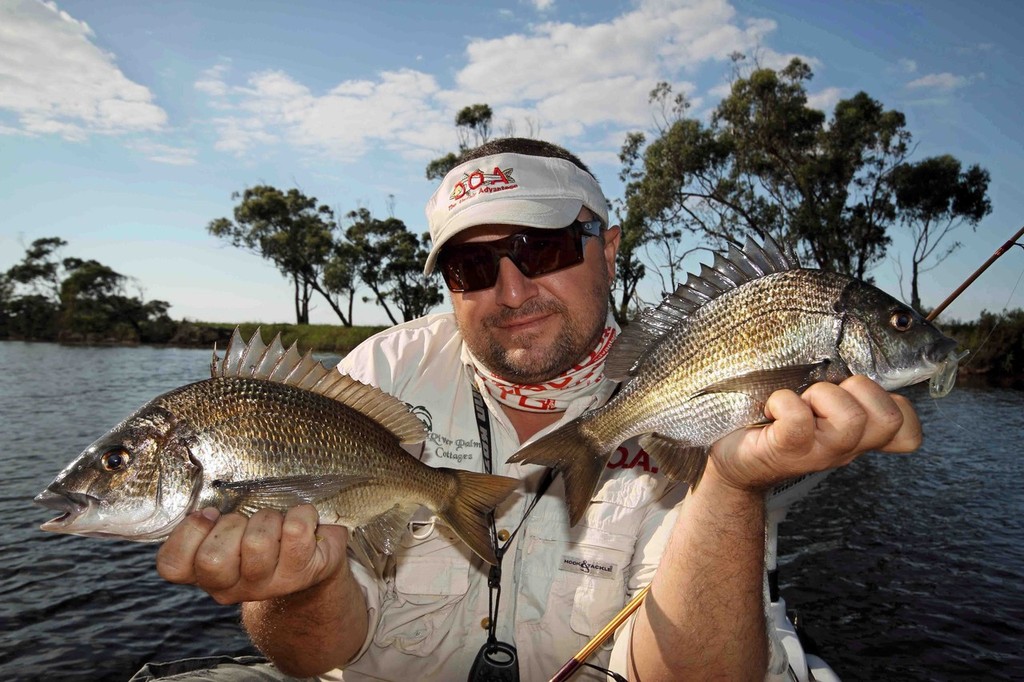Bream on Hardbodies
by Jarrod Day on 19 Dec 2012

Frank displays two solid bream. Jarrod Day
Lure fishing for bream is one of the more challenging ways to target them in estuaries and is undoubtedly one of the most adrenalin, knee trembling battles an angler can experience.
There is nothing more exciting than flicking a tiny lure amongst a plethora of submerged dead trees only to have a fish burst from beneath a log in seconds before busting you off on the barnacle encrusted timber.
This style of fishing is highly addictive, the reason that so many anglers around the country pursue such sport.
There is a high finesse technique involved along with an understanding of this species to allow anglers to know which lures will work in different scenarios. Not every two days are the same with bream where one day they could be feeding off the surface while the next down deep. Either way, by having a wide lure selection and being able to read into how the fish are feeding on that day will allow you to adapt to further your success.
The outfit: Flicking such light lures requires an extremely light outfit. Rods with a 7ft length having a line rating of 1-3 kilos are recommended. This style of rod allows accurate casting of such light lures when used in conjunction with 2500 or 1000 series reels. These should be spooled with either four or six pound leader, the choice is yours. Due to the finicky nature of bream, leader material should be either six or eight pound, any heavier and they will shy from the lure.
The lures: Amongst the hundreds of different styles of lures available for bream you will require a selection. This is because their feeding patterns always change from feeding on the surface, mid water and deep under the timber. For any surface luring, 50-70mm surface walkers and or poppers are recommended. Suspending, sinking and floating diving lures in the 50 – 70mm range are also recommended when the fish are feeding deep. Lures such as Yo-Zuri 50mm Hardcore minnows and Eba Shads are proven bream lures. Both are available in a sinking and floating versions in a wide colour array.
The technique: Flicking for bream requires anglers to have a finesse approach, this entails making an accurate cast towards the timber or bank. Once the lure has hit the water, two or three small light twitches of the rod will bring the lure under the surface. The lure should be twitched a further two or three times with a 3-5 second pause. If the lure isn’t taken on the pause, twitch again repeating the process. It is once the lure has paused that the lure will be eaten. While twitching the lure, continually keep the line tight to the lure by winding the lures handle. When the lure is stationary, the angler must keep the line tight to feel for the take. While doing this, constantly watch the line where it enters the water. If you notice a tick or the lure pull tight this is a clear indication that a fish has struck the lure. This is the point in which you should strike to set the hooks.
Once a fish has been hooked, you need to go hard early dragging the fish from the timber. If you’re not quick enough, the fish will dive beneath the timber often busting you off.
Finding bream: Bream are both a scavenger and a hunter. Estuaries that are affected by tide can fish in different ways. On the high tide, the fish are often higher in the water feeding on the edges, amongst the timber or hunting schools of baitfish. This is when anglers can work the edges with shallow diving hard body or surface baits. In this situation bream will be in hunting mode where you’ll find them quite aggressive.
On the low, the fish are often deeper feeding on barnacles and other crustaceans. The difficulty in this situation is that you have to get your lure to them. This entails using either soft plastics or sinking hard bodies. Unfortunately, to be successful you have to run the risk of losing a few lures and you will.
Allowing the lure to sink before gently giving it a twitch is all it takes to fire them up to entice a strike.
Once a bite is felt, it is imperative the hook is set and you stick it to the hard to pull them from the snag. If not, it’s bye, bye fish and your lure.
If you want to link to this article then please use this URL: www.sail-world.com/104811